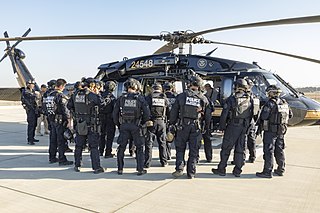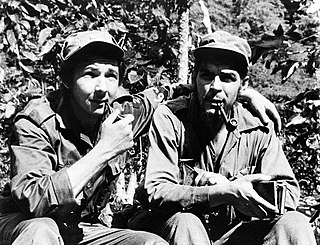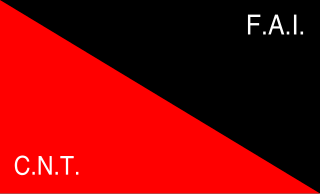Military urbanism is the militarization of urban areas. This can include changes to built environments in military conflict areas or modifications of cityscapes to strengthen or subvert control by authorities. Military urbanism concerns the planning and implementation processes by which areas are fortified and militarized.

Guerrilla warfare is a form of irregular warfare in which small groups of combatants, such as paramilitary personnel, armed civilians, or irregulars, use military tactics including ambushes, sabotage, raids, petty warfare, hit-and-run tactics, and mobility, to fight a larger and less-mobile traditional military.

A military, also known collectively as armed forces, is a heavily armed, highly organized force primarily intended for warfare. It is typically authorized and maintained by a sovereign state, with its members identifiable by their distinct military uniform. It may consist of one or more military branches such as an army, navy, air force, space force, marines, or coast guard. The main task of the military is usually defined as defence of the state and its interests against external armed threats.

In the United States, a SWAT team is a police tactical unit that uses specialized or military equipment and tactics. Although they were first created in the 1960s to handle riot control or violent confrontations with criminals, the number and usage of SWAT teams increased in the 1980s and 1990s during the War on Drugs and later in the aftermath of the September 11 attacks. In the United States by 2005, SWAT teams were deployed 50,000 times every year, almost 80% of the time to serve search warrants, most often for narcotics. By 2015 that number had increased to nearly 80,000 times a year. SWAT teams are increasingly equipped with military-type hardware and trained to deploy against threats of terrorism, for crowd control, hostage taking, and in situations beyond the capabilities of ordinary law enforcement, sometimes deemed "high-risk".

A paramilitary is an organization whose structure, tactics, training, subculture, and (often) function are similar to those of a professional military, but is not part of a country's official or legitimate armed forces. Paramilitary units carry out duties that a country's military or police forces are unable or unwilling to handle. Other organizations may be considered paramilitaries by structure alone, despite being unarmed or lacking a combat role.

Urban warfare is warfare in urban areas such as towns and cities. Urban combat differs from combat in the open at both the operational and the tactical levels. Complicating factors in urban warfare include the presence of civilians and the complexity of the urban terrain. Urban combat operations may be conducted to capitalize on strategic or tactical advantages associated with the possession or the control of a particular urban area or to deny these advantages to the enemy.

Close-quarters combat (CQC) or close-quarters battle (CQB) is a close combat situation between multiple combatants involving ranged or melee combat. It can occur between military units, law enforcement and criminal elements, and in other similar situations.

In politics and military planning, a war effort is a coordinated mobilization of society's resources—both industrial and human—towards the support of a military force. Depending on the militarization of the culture, the relative size of the armed forces and the society supporting them, the style of government, and the famous support for the military objectives, such war effort can range from a small industry to complete command of society.

Modern warfare is warfare that is in notable contrast with previous military concepts, methods, and technology, emphasizing how combatants must modernize to preserve their battle worthiness. As such, it is an evolving subject, seen differently in different times and places. In its narrowest sense, it is merely a synonym for contemporary warfare.
Network-centric warfare, also called network-centric operations or net-centric warfare, is a military doctrine or theory of war that aims to translate an information advantage, enabled partly by information technology, into a competitive advantage through the computer networking of dispersed forces. It was pioneered by the United States Department of Defense in the 1990s.
Militarization, or militarisation, is the process by which a society organizes itself for military conflict and violence. It is related to militarism, which is an ideology that reflects the level of militarization of a state. The process of militarization involves many interrelated aspects that encompass all levels of society.
The history of the People's Liberation Army began in 1927 with the start of the Chinese Civil War and spans to the present, having developed from a peasant guerrilla force into the largest armed force in the world.
Land warfare or ground warfare is the process of military operations eventuating in combat that takes place predominantly on the battlespace land surface of the planet.

The Aro Confederacy (1690–1902) was a political union orchestrated by the Aro people, Igbo subgroup, centered in Arochukwu in present-day southeastern Nigeria. Their influence and presence was all over Eastern Nigeria, lower Middle Belt, and parts of present-day Cameroon and Equatorial Guinea during the 18th and 19th centuries. The Arochukwu Kingdom was an economic, political, and an oracular center as it was home of the Ibini Ukpabi oracle, High Priests, the Aro King Eze Aro, and central council (Okpankpo).

A guerilla foco is a small cadre of revolutionaries operating in a nation's countryside. This guerilla organization was popularized by Che Guevara in his book Guerilla Warfare, which was based on his experiences in the Cuban Revolution. Guevara would go on to argue that a foco was politically necessary for the success of a socialist revolution. Originally Guevara theorized that a foco was only useful in overthrowing personalistic military dictatorships and not liberal democratic capitalism where a peaceful overthrow was believed possible. Years later Guevara would revise his thesis and argue all nations in Latin America, including liberal democracies could be overthrown by a guerilla foco. Eventually the foco thesis would be that political conditions would not even need to be ripe for revolutions to be successful, since the sheer existence of a guerilla foco would create ripe conditions by itself. Guevara's theory of foco known as foquismo was self-described as the application of Marxism-Leninism to Latin American conditions, and would later be further popularized by author Régis Debray. The proposed necessity of a guerilla foco proved influential in Latin America, but was also heavily criticized by other socialists.

Airpower or air power consists of the application of military aviation, military strategy and strategic theory to the realm of aerial warfare and close air support. Airpower began in the advent of powered flight early in the 20th century. Airpower represents a "complex operating environment that has been subjected to considerable debate". British doctrine defines airpower as "the ability to project power from the air and space to influence the behaviour of people or the course of events." The Australian Experience of Air Power defines Airpower as being composed of Control of the Air, Strike, Intelligence Surveillance and Reconnaissance, and Air Mobility roles.
The following outline is provided as an overview of and topical guide to war:

Guevarism is a theory of communist revolution and a military strategy of guerrilla warfare associated with Marxist–Leninist revolutionary Ernesto "Che" Guevara, a leading figure of the Cuban Revolution who believed in the idea of Marxism–Leninism and embraced its principles.

Artsrun Karapeti Hovhannisyan is the former press secretary of the Ministry of Defence of Armenia, a military expert and analyst. From March to July 2020 he held the position of Head of the Command and Staff Faculty at the Vazgen Sargsyan Military University, and from July of the same year - Head of the HR and Education Department. He is the author of numerous articles, monographs, works, reviews. From September 27 to November 9, 2020, during the Armenian-Azerbaijani war, he chaired the daily press conferences of the Armenian United Platform Center and presented the official position of the Republic of Armenia.

The militarization of police is the use of military equipment and tactics by law enforcement officers. This includes the use of armored personnel carriers (APCs), assault rifles, submachine guns, flashbang grenades, sniper rifles, and SWAT teams. The militarization of law enforcement is also associated with intelligence agency–style information gathering aimed at the public and political activists and with a more aggressive style of law enforcement. Criminal justice professor Peter Kraska has defined militarization of police as "the process whereby civilian police increasingly draw from, and pattern themselves around, the tenets of militarism and the military model".

The confederal militias were a movement of people's militia organized during the Spanish civil war by the dominant organizations of anarchism in Spain: the National Confederation of Labor (CNT) and the Iberian Anarchist Federation (FAI).